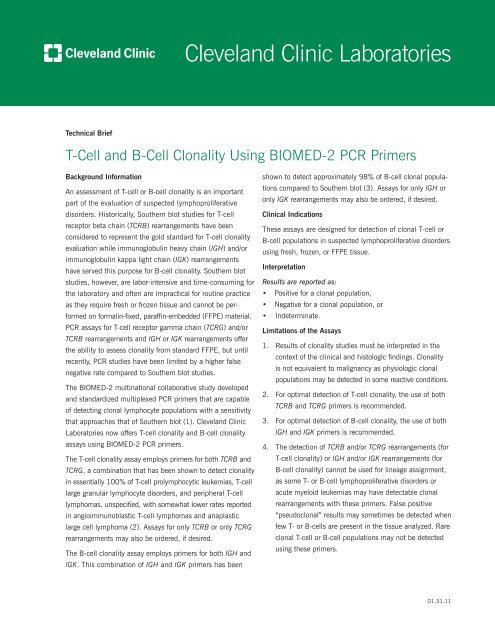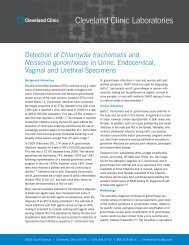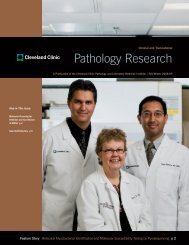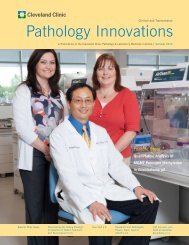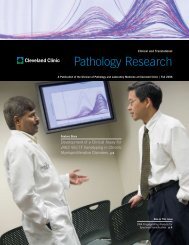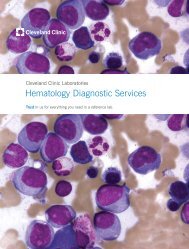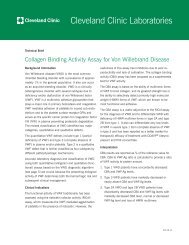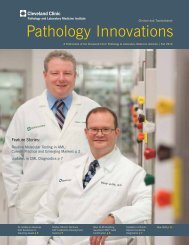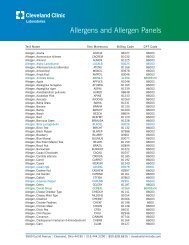Cleveland Clinic Laboratories > Home
Cleveland Clinic Laboratories > Home
Cleveland Clinic Laboratories > Home
Create successful ePaper yourself
Turn your PDF publications into a flip-book with our unique Google optimized e-Paper software.
<strong>Cleveland</strong> <strong>Clinic</strong> <strong>Laboratories</strong><br />
Technical Brief<br />
T-Cell and B-Cell Clonality Using BIOMED-2 PCR Primers<br />
Background Information<br />
An assessment of T-cell or B-cell clonality is an important<br />
part of the evaluation of suspected lymphoproliferative<br />
disorders. Historically, Southern blot studies for T-cell<br />
receptor beta chain (TCRB) rearrangements have been<br />
considered to represent the gold standard for T-cell clonality<br />
evaluation while immunoglobulin heavy chain (IGH) and/or<br />
immunoglobulin kappa light chain (IGK) rearrangements<br />
have served this purpose for B-cell clonality. Southern blot<br />
studies, however, are labor-intensive and time-consuming for<br />
the laboratory and often are impractical for routine practice<br />
as they require fresh or frozen tissue and cannot be performed<br />
on formalin-fixed, paraffin-embedded (FFPE) material.<br />
PCR assays for T-cell receptor gamma chain (TCRG) and/or<br />
TCRB rearrangements and IGH or IGK rearrangements offer<br />
the ability to assess clonality from standard FFPE, but until<br />
recently, PCR studies have been limited by a higher false<br />
negative rate compared to Southern blot studies.<br />
The BIOMED-2 multinational collaborative study developed<br />
and standardized multiplexed PCR primers that are capable<br />
of detecting clonal lymphocyte populations with a sensitivity<br />
that approaches that of Southern blot (1). <strong>Cleveland</strong> <strong>Clinic</strong><br />
<strong>Laboratories</strong> now offers T-cell clonality and B-cell clonality<br />
assays using BIOMED-2 PCR primers.<br />
The T-cell clonality assay employs primers for both TCRB and<br />
TCRG, a combination that has been shown to detect clonality<br />
in essentially 100% of T-cell prolymphocytic leukemias, T-cell<br />
large granular lymphocyte disorders, and peripheral T-cell<br />
lymphomas, unspecified, with somewhat lower rates reported<br />
in angioimmunoblastic T-cell lymphomas and anaplastic<br />
large cell lymphoma (2). Assays for only TCRB or only TCRG<br />
rearrangements may also be ordered, if desired.<br />
The B-cell clonality assay employs primers for both IGH and<br />
IGK. This combination of IGH and IGK primers has been<br />
shown to detect approximately 98% of B-cell clonal populations<br />
compared to Southern blot (3). Assays for only IGH or<br />
only IGK rearrangements may also be ordered, if desired.<br />
<strong>Clinic</strong>al Indications<br />
These assays are designed for detection of clonal T-cell or<br />
B-cell populations in suspected lymphoproliferative disorders<br />
using fresh, frozen, or FFPE tissue.<br />
Interpretation<br />
Results are reported as:<br />
• Positive for a clonal population,<br />
• Negative for a clonal population, or<br />
• Indeterminate.<br />
Limitations of the Assays<br />
1. Results of clonality studies must be interpreted in the<br />
context of the clinical and histologic findings. Clonality<br />
is not equivalent to malignancy as physiologic clonal<br />
populations may be detected in some reactive conditions.<br />
2. For optimal detection of T-cell clonality, the use of both<br />
TCRB and TCRG primers is recommended.<br />
3. For optimal detection of B-cell clonality, the use of both<br />
IGH and IGK primers is recommended.<br />
4. The detection of TCRB and/or TCRG rearrangements (for<br />
T-cell clonality) or IGH and/or IGK rearrangements (for<br />
B-cell clonality) cannot be used for lineage assignment,<br />
as some T- or B-cell lymphoproliferative disorders or<br />
acute myeloid leukemias may have detectable clonal<br />
rearrangements with these primers. False positive<br />
“pseudoclonal” results may sometimes be detected when<br />
few T- or B-cells are present in the tissue analyzed. Rare<br />
clonal T-cell or B-cell populations may not be detected<br />
using these primers.<br />
01.31.11
Methodology<br />
PCR is performed utilizing the standardized BIOMED-2<br />
protocol (1).<br />
PCR products are analyzed using capillary electrophoresis.<br />
For T-cell clonality: Rearrangements of the TCRB locus are<br />
assessed using three sets of labeled multiplexed PCR primers.<br />
The first two tubes consist of forward primers targeting V<br />
variable segments and reverse primers targeting the J joining<br />
region. The third TCRB tube detects incomplete rearrangements<br />
using forward primers to the D diversity segments and<br />
reverse primers targeting the J joining regions. Rearrangements<br />
of the TCRG locus are assessed using two sets of multiplexed<br />
labeled PCR primers, each with forward primers for the V<br />
variable regions and reverse primers targeting the J joining<br />
region.<br />
For B-cell clonality: Rearrangements of the IGH locus are<br />
assessed using three sets of labeled multiplexed PCR primers.<br />
These tubes consist of forward primers targeting the IGH<br />
variable framework 1, framework 2, or framework 3 region<br />
with common reverse primers to the JH joining region.<br />
Rearrangements of the IGK locus are assessed using two<br />
sets of multiplexed labeled PCR primers. The first tube uses<br />
forward primers for the kappa variable regions and a reverse<br />
primer targeting the J joining region. The second tube uses<br />
forward primers to the kappa variable regions and an intron<br />
primer together with a reverse primer targeting the kappa<br />
locus deleting element.<br />
References<br />
1. JJM VanDongen, AW Langerak, M Bruggermann et al.<br />
Design and standardization of PCR primers and protocols<br />
for detection of clonal immunoglobulin and T-cell receptor<br />
gene recombinations in suspect lymphoproliferations:<br />
Report of the BIOMED-2 Concerted Action BMH4-CT98-<br />
3936. Leukemia. 2003;17:2257-2317.<br />
2. M Bruggermann, H White, P Gaulard et al. Powerful<br />
strategy for polymerase chain reaction-based clonality<br />
assessment in T-cell malignancies: Report of the<br />
BIOMED-2 Concerted Action BHM4-CT98-3936.<br />
Leukemia. 2007;21:215-221.<br />
3. PAS Evans, Ch Pott, PJTA Groenen et al. Significantly<br />
improved PCR-based clonality testing in B-cell malignancies<br />
by use of multiple immunoglobulin gene targets.<br />
Report of the BIOMED-2 Concerted Action BHM4-CT-<br />
98-3936. Leukemia. 2007;21:207-214.
Test Overview<br />
Test Name<br />
T-Cell Clonality Using BIOMED-2<br />
PCR Primers<br />
T-Cell Receptor Beta BIOMED-2<br />
PCR<br />
TCR-G (PCR)<br />
Reference Range<br />
Negative for clonal rearrangement<br />
Negative for clonal rearrangement<br />
Negative for clonal rearrangement<br />
Specimen Requirements<br />
External Specimen Requirements:<br />
Testing Volume/Size: 10 mm 2<br />
Type: Tissue, frozen<br />
Tube/Container: Clean container<br />
Note: Frozen tissue should be<br />
delivered to Surgical Pathology for<br />
accessioning and cutting.<br />
Testing Volume/Size: 10 mm 2<br />
Type: Tissue, paraffin-embedded<br />
Tube/Container: Clean container<br />
Note: Paraffin-embedded tissue<br />
should be delivered to Surgical<br />
Pathology for accessioning and<br />
cutting.<br />
Alternate Specimen Requirements:<br />
Testing Volume/Size: 2 mL<br />
Type: Bone marrow<br />
Tube/Container: EDTA (Lavender)<br />
Transport Temperature: Refrigerated<br />
Testing Volume/Size: 2 mL<br />
Type: Fluid, body<br />
Tube/Container: EDTA (Lavender)<br />
Transport Temperature: Refrigerated<br />
Note: Fluid must contain at least<br />
3 million cells.<br />
Testing Volume/Size: 8 mL<br />
Type: Whole blood<br />
Tube/Container: EDTA (Lavender)<br />
Transport Temperature: Refrigerated<br />
External Specimen Requirements:<br />
Testing Volume/Size: 10 mm 2<br />
Type: Tissue, frozen<br />
Tube/Container: Clean container<br />
Transport Temperature: Frozen<br />
Note: Paraffin-embedded tissue<br />
should be delivered to Anatomic<br />
Pathology for accessioning and<br />
cutting.<br />
Testing Volume/Size: 10 mm 2<br />
Type: Tissue, paraffin-embedded<br />
Tube/Container: Clean container<br />
Note: Paraffin-embedded tissue<br />
should be delivered to Anatomic<br />
Pathology for accessioning and<br />
cutting.<br />
Alternate Specimen Requirements:<br />
Testing Volume/Size: 2 mL<br />
Type: Bone marrow<br />
Tube/Container: EDTA (Lavender)<br />
Transport Temperature: Refrigerated<br />
Testing Volume/Size: 2 mL<br />
Type: Fluid, body<br />
Tube/Container: EDTA (Lavender)<br />
Transport Temperature: Refrigerated<br />
Note: Fluid must contain at least<br />
3 million cells.<br />
Testing Volume/Size: 5 mL<br />
Type: Whole blood<br />
Tube/Container: EDTA (Lavender)<br />
Transport Temperature: Refrigerated<br />
Testing Volume/Size: Other<br />
Type: Extracted DNA<br />
Tube/Container: Clean container<br />
Transport Temperature: Frozen<br />
Note: Volume/Size: 6µg<br />
External Specimen Requirements:<br />
Testing Volume/Size: 10 mm 2<br />
Type: Tissue, frozen<br />
Tube/Container: Clean container<br />
Transport Temperature: Frozen<br />
Note: Send specimen at -70°C on<br />
dry ice.<br />
Testing Volume/Size: 10 mm 2<br />
Type: Tissue, paraffin-embedded<br />
Tube/Container: Clean container<br />
Transport Temperature: Ambient<br />
Alternate Specimen Requirements:<br />
Testing Volume/Size: 2 mL<br />
Type: Bone marrow<br />
Tube/Container: EDTA (Lavender)<br />
Transport Temperature: Refrigerated<br />
Testing Volume/Size: 2 mL<br />
Type: Fluid, body<br />
Tube/Container: EDTA (Lavender)<br />
Transport Temperature: Refrigerated<br />
Note: Fluid must contain at least<br />
3 million cells.<br />
Testing Volume/Size: 8 mL<br />
Type: Whole blood<br />
Tube/Container: EDTA (Lavender)<br />
Transport Temperature: Refrigerated<br />
Test Ordering Information<br />
Clearly indicate specimen source<br />
on sample label<br />
Clearly indicate specimen source<br />
on sample label<br />
Clearly indicate specimen source<br />
on sample label<br />
Billing Code 87903<br />
CPT Code 83891; 83898; 83900;<br />
83901(x7); 83909(x5); 83912<br />
87965<br />
83891; 83898; 83900;<br />
83901(x3); 83909(x3); 83912<br />
81402<br />
83891; 83900; 83901(x4);<br />
83909(x2); 83912
<strong>Cleveland</strong> <strong>Clinic</strong> <strong>Laboratories</strong><br />
9500 Euclid Avenue, L15, <strong>Cleveland</strong>, Ohio 44195<br />
800.628.6816 | clevelandcliniclabs.com<br />
Test Overview<br />
Test Name<br />
B-Cell Clonality Using BIOMED-2<br />
PCR Primers<br />
Immunoglobulin Heavy Chain<br />
Using BIOMED-2 PCR Primers<br />
Immunoglobulin Kappa Chain<br />
Using BIOMED-2 PCR Primers<br />
Reference Range<br />
Negative for clonal rearrangement<br />
Negative for clonal rearrangement<br />
Negative for clonal rearrangement<br />
Specimen Requirements<br />
External Specimen Requirements:<br />
Testing Volume/Size: 10 mm 2<br />
Type: Tissue<br />
Tube/Container: Clean container<br />
Note: May submit fresh, frozen or<br />
paraffin-embedded tissue<br />
Alternate Specimen Requirements:<br />
Testing Volume/Size: 2 mL<br />
Type: Bone marrow<br />
Tube/Container: EDTA (Lavender)<br />
Transport Temperature: Refrigerated<br />
Testing Volume/Size: 2 mL<br />
Type: Fluid, body<br />
Tube/Container: EDTA (Lavender)<br />
Transport Temperature: Refrigerated<br />
Note: Fluid must contain at least<br />
3 million cells.<br />
Testing Volume/Size: 8 mL<br />
Type: Whole blood<br />
Tube/Container: EDTA (Lavender)<br />
Transport Temperature: Refrigerated<br />
External Specimen Requirements:<br />
Testing Volume/Size: 10 mm 2<br />
Type: Tissue<br />
Tube/Container: Clean container<br />
Transport Temperature: Frozen<br />
Note: Frozen and fresh tissue<br />
should be delivered to Surgical<br />
Pathology for accessioning and<br />
cutting. Paraffin-embedded tissue<br />
should be delivered to Anatomic<br />
Pathology for accessioning and<br />
cutting.<br />
Alternate Specimen Requirements:<br />
Testing Volume/Size: 2 mL<br />
Type: Bone marrow<br />
Tube/Container: EDTA (Lavender)<br />
Transport Temperature: Refrigerated<br />
Testing Volume/Size: 8 mL<br />
Type: Blood<br />
Tube/Container: EDTA (Lavender)<br />
Transport Temperature: Refrigerated<br />
Testing Volume/Size: Other<br />
Type: Extracted DNA<br />
Tube/Container: EDTA (Lavender)<br />
Transport Temperature: Frozen<br />
Note: Volume/Size: 6 µg<br />
External Specimen Requirements:<br />
Testing Volume/Size: 10 mm 2<br />
Type: Tissue<br />
Tube/Container: Clean container<br />
Transport Temperature: Frozen<br />
Note: Frozen and fresh tissue<br />
should be delivered to Surgical<br />
Pathology for accessioning and<br />
cutting. Paraffin-embedded tissue<br />
should be delivered to Anatomic<br />
Pathology for accessioning and<br />
cutting.<br />
Alternate Specimen Requirements:<br />
Testing Volume/Size: 2 mL<br />
Type: Bone marrow<br />
Tube/Container: EDTA (Lavender)<br />
Transport Temperature: Refrigerated<br />
Testing Volume/Size: 8 mL<br />
Type: Blood<br />
Tube/Container: EDTA (Lavender)<br />
Transport Temperature: Refrigerated<br />
Testing Volume/Size: Other<br />
Type: Extracted DNA<br />
Tube/Container: Clean container<br />
Transport Temperature: Frozen<br />
Note: Volume/Size: 6 µg<br />
Test Ordering Information<br />
Clearly indicate specimen source<br />
on sample label<br />
Clearly indicate specimen source<br />
on sample label<br />
Clearly indicate specimen source<br />
on sample label<br />
Billing Code 87904<br />
CPT Code 83891; 83898(x3); 83900;<br />
83901(x2); 83909(x5); 83912<br />
87960<br />
83891; 83898(x3); 83909(x3);<br />
83912<br />
87954<br />
83891; 83900; 83901(x4);<br />
83909(x2); 83912<br />
Technical Information Contact:<br />
Kelly Lyon, MT<br />
216.444.8283<br />
palinck@ccf.org<br />
Scientific Information Contact:<br />
James R. Cook, MD, PhD<br />
216.444.4435<br />
cookj2@ccf.org<br />
201101.025


